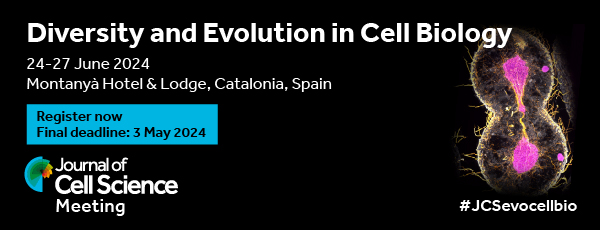Issues
-
Cover image
Cover Image

Cover: Retinal pigment epithelial (RPE-1) cell on a crossbow-shaped micropattern. It was fixed with paraformaldehyde and immunostained with primary antibodies against α-actinin (green) and fluorescently labelled phalloidin (magenta) to reveal actin filaments. See article by F. Senger et al. (jcs236604).
- PDF Icon PDF LinkTable of contents
- PDF Icon PDF LinkIssue info
RESEARCH HIGHLIGHTS
FIRST PERSON
CELL SCIENCE AT A GLANCE
The liquid nucleome – phase transitions in the nucleus at a glance
Summary: This Cell Science at a Glance article discusses how membrane-less compartments in the nucleus are formed by phase separation and help to organize and regulate nuclear functions.
REVIEW
Multiscale dynamics of tight junction remodeling
Summary: This Review discusses how tight junction remodeling at multiple scales contributes to sustained epithelial barrier function in the face of cell and tissue dynamics.
SHORT REPORTS
A homeostatic mechanism rapidly corrects aberrant nucleocytoplasmic ratios maintaining nuclear size in fission yeast
Summary: Nuclear size homeostasis is achieved by a rapid correction mechanism modulating nuclear growth rate in growing fission yeast cells.
Yap induces osteoblast differentiation by modulating Bmp signalling during zebrafish caudal fin regeneration
Summary: Yap regulates, in a non-cell-autonomous manner, Bmp signalling activation in osteoprogenitors, thereby promoting osteoblast differentiation and proper bone formation during zebrafish caudal fin regeneration.
MICAL-L1 coordinates ciliogenesis by recruiting EHD1 to the primary cilium
Highlighted Article: A pool of centriolar γ-tubulin and/or α/β-tubulins anchor MICAL-L1 to the centriole, where it might recruit EHD1 to promote ciliogenesis.
RESEARCH ARTICLES
Condensin II protein dysfunction impacts mitochondrial respiration and mitochondrial oxidative stress responses
Highlighted Article: Condensin II proteins localize to mitochondria, and their depletion results in defects in oxygen consumption rates, changes in ATP levels and inefficient mitochondrial responses to oxidative stress.
Two conserved glycine residues in mammalian and Dictyostelium Rictor are required for mTORC2 activity and integrity
Summary: Two glycine residues are essential for the mTORC2 activity and integrity in organisms that are distantly related, suggesting they have a conserved role in mTORC2 assembly and functioning.
Role for the splicing factor TCERG1 in Cajal body integrity and snRNP assembly
Highlighted Article: The results suggest a new role for TCERG1 in the formation of Cajal bodies and the biogenesis of snRNPs, which may have a functional consequence for pre-mRNA processing.
Vac8 spatially confines autophagosome formation at the vacuole in S. cerevisiae
Highlighted Article: Vac8 tethers the phagophore assembly site to the vacuole, which creates a confined space for autophagosome biogenesis and coordinates autophagosome formation with vacuolar fusion.
Spatial integration of mechanical forces by α-actinin establishes actin network symmetry
Highlighted Article: In the absence of α-actinin, a cross-linker of actin filaments, the symmetry of the cellular actin architecture is no longer in accordance with the geometry of extracellular cues.
PREPRINT HIGHLIGHTS
Introducing our new Editors

We welcome three new Editors to Journal of Cell Science - Robert Parton, Richa Rikhy and Simon Cook. You can read more about them in the Editorial from our Editor-in-Chief Michael Way.
2024 Journal Meeting 'Diversity and Evolution in Cell Biology'

Registration is open for our 2024 Journal Meeting Diversity and Evolution in Cell Biology, which aims to bring together evolutionary biologists and cell biologists investigating diverse aspects of cellular physiology. Final registration deadline: 3 May 2024.
Workshop: Physics of the Early Embryonic Cell Divisions

Early-career researchers interested in the roles of nuclear lipids, apply now for one of the ten funded places at this Workshop, which will take place 11-14 November 2024. Application deadline: 17 May.
Reasons to submit to Journal of Cell Science

There are many benefits to publishing in Journal of Cell Science - read more about why you should choose JCS or visit our submission page now.
Propose a new Workshop for 2026

We are now accepting proposals for our 2026 Workshops programme. We aim to be responsive to the community and open to novel initiatives, so if you have a new idea for a biological workshop that you feel would work well, please apply. Applications deadline: 19 July 2024.



